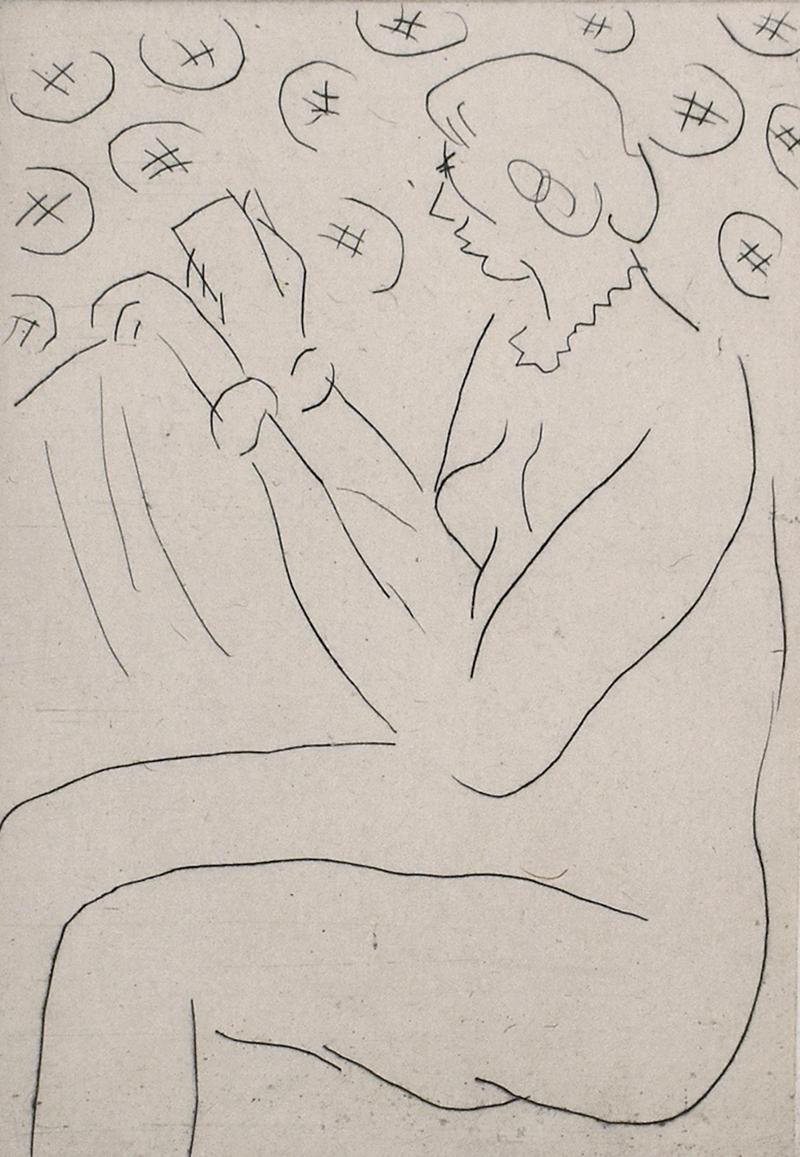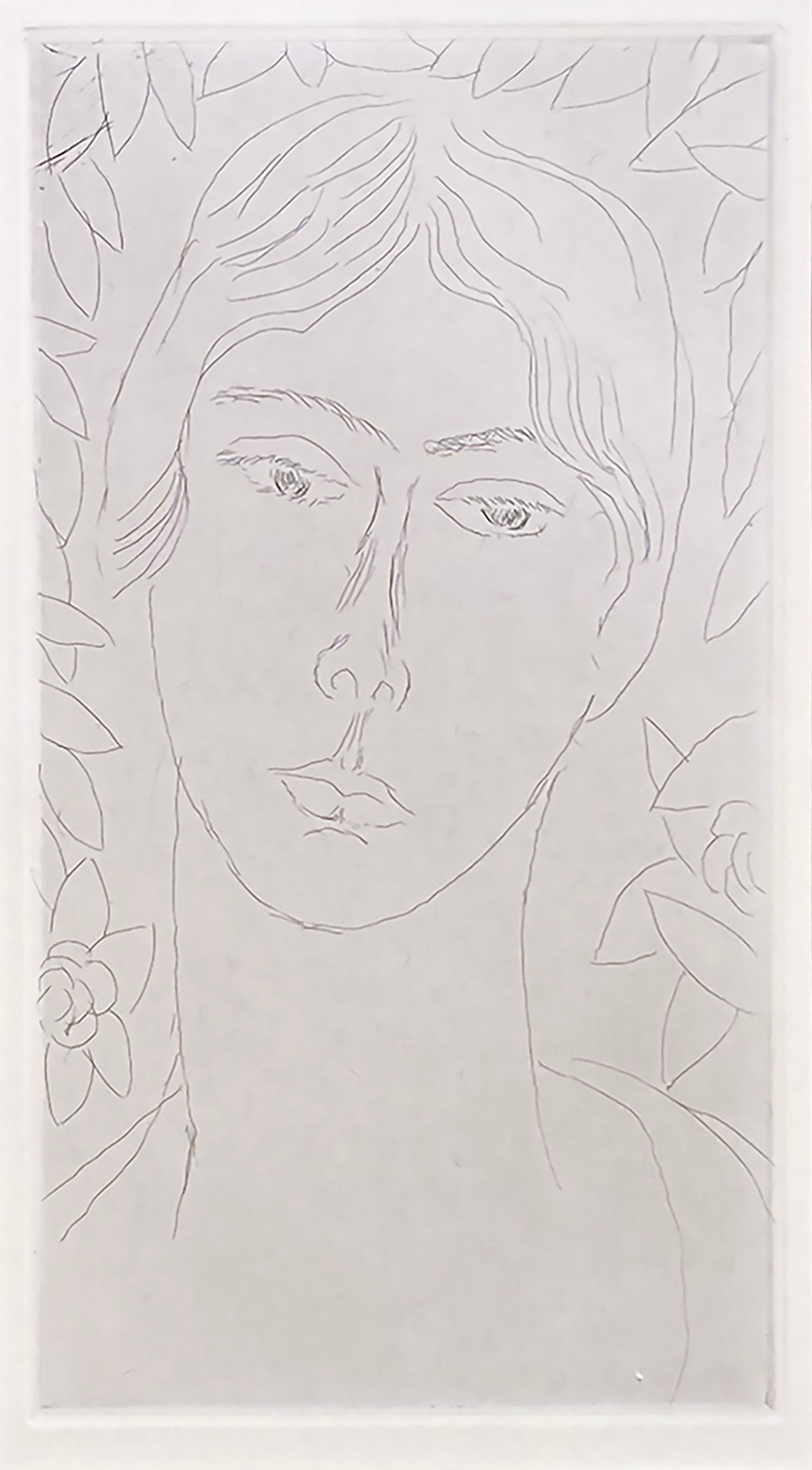Items Similar to LE MARIN
Want more images or videos?
Request additional images or videos from the seller
1 of 6
Charles DufresneLE MARIN1923
1923
About the Item
Dufresne, Charles. LE MARIN. Etching, colored with pochoir, 1923. 12 15/16 x 15 5/8 inches (315 x 400 mm.). Edition of 40. Signed, titled and numbered in pencil in the lower margin, and with the blindstamp of Sagot. Excellent condition.
- Creator:Charles Dufresne (1876-1938, French)
- Creation Year:1923
- Dimensions:Height: 18 in (45.72 cm)Width: 24 in (60.96 cm)
- Medium:
- Movement & Style:
- Period:
- Condition:
- Gallery Location:Portland, ME
- Reference Number:
About the Seller
5.0
Recognized Seller
These prestigious sellers are industry leaders and represent the highest echelon for item quality and design.
Platinum Seller
These expertly vetted sellers are 1stDibs' most experienced sellers and are rated highest by our customers.
Established in 1966
1stDibs seller since 2016
296 sales on 1stDibs
Typical response time: 2 hours
Associations
International Fine Print Dealers Association
- ShippingRetrieving quote...Ships From: Portland, ME
- Return PolicyA return for this item may be initiated within 10 days of delivery.
More From This SellerView All
- LA TOILETTE ASSISEBy Pierre BonnardLocated in Portland, MEBonnard, Pierre. LA TOILETTE ASSISE (Woman Dressing, Seated). Bouvet, 96. Lithograph printed in black, 1925. First State, before the addition of the Monogr...Category
1920s Post-Impressionist Figurative Prints
MaterialsLithograph
- SUGAR MAPLESBy Chauncey Foster RyderLocated in Portland, MERyder, Chauncey. SUGAR MAPLES. Etching & Drypoint, c. 1920. Edition size not known. Signed and titled in pencil. 9 7/8 x 11 3/4 inches, 256 x 300 mm. In excellent condition except fo...Category
1920s Landscape Prints
MaterialsDrypoint, Etching
- RESTAURANT IN CHINATOWNBy Charles Frederick William MielatzLocated in Portland, MEMielatz, Charles. RESTAURANT IN CHINATOWN. Etching, 1906. Edition size not known. Signed and inscribed "imp."in pencil, and signed and dated in the plate. Printed on Japan paper with...Category
Early 1900s Landscape Prints
MaterialsEtching
- CAKE WALK DES PETITES FILLESBy Jacques VillonLocated in Portland, MEVillon, Jacques. CAKE WALK DES PETITES FILLES. GP.102, second state of four. Drypoint and aquatint in colors, 1904. Edition of only 10 (there was an edition of 30 in state 4, with th...Category
Early 1900s Figurative Prints
MaterialsDrypoint, Aquatint
- THE STORMLocated in Portland, MEPeterdi, Gabor (American, born Hungary, 1915-2001). THE STORM. Johnson 154) Etching and engraving, 1958. Edition of 15, signed, dated, titled and numbered 3-15 in pencil. 22 x 32 inc...Category
1950s Abstract Prints
MaterialsEngraving, Etching
- WINDSWEPT TREESBy Chauncey Foster RyderLocated in Portland, MERyder, Chauncey. WINDSWEPT TREES. Etching & Drypoint, c. 1920. Edition size not known. Signed and titled in pencil. 8 7/8 x 11 7/8 inches, 225 x 302 mm. In excellent condition except...Category
1920s Landscape Prints
MaterialsDrypoint, Etching
You May Also Like
- Figure Reading - Etching - Fauvism - French ArtBy Henri MatisseLocated in London, GBHENRI MATISSE 1869-1954 (Emile Benoît) Le Cateau-Cambrésis 1869-1954 Nice (French) Title: Figure Reading Figure lisant, 1929 Technique: Original Hand Signed and Numbered Etching o...Category
1920s Fauvist Figurative Prints
MaterialsEtching
- La Baigneuse aux PapillonsBy Raoul DufyLocated in San Francisco, CAThis artwork titled "La Baigneuse aux Papillons" c.1930 in an etching on paper by French artist Raoul Dufy, 1877-1963. Unsigned as issue. Printed/publishe...Category
Mid-20th Century Fauvist Nude Prints
MaterialsEtching
- "Mlle Landsberg" (grade planche, pl. 16)By Henri MatisseLocated in Missouri, MO"Mlle Landsberg" (grade planche, pl. 16), 1914 Henri Matisse (French, 1869-1954) Signed and Numbered Lower Right Edition 12/15 Image size: 7 7/8 x 4 5/16 inches Sheet size: 17 11/16 x 12 1/2 inches With frame: 19 1/2 x 14 1/2 inches Henri Matisse came from a family who were of Flemish origin and lived near the Belgian border. At eight o'clock on the evening of December 31, 1869, he was born in his grandparents' home in the town of Le Cateau in the cheerless far north of France. His father was a self-made seed merchant who was a mixture of determination and tightly coiled tension. Henri had no clear idea of what he wanted to do with his life. He was a twenty-year-old law clerk convalescing from appendicitis when he first began to paint, using a box of colors given to him by his mother. Little more than a year later, in 1890, he had abandoned law and was studying art in Paris. The classes consisted of drawing from plaster casts and nude models and of copying paintings in the Louvre. He soon rebelled against the school's conservative atmosphere; he replaced the dark tones of his earliest works with brighter colors that reflected his awareness of Impressionism. Matisse was also a violinist; he took an odd pride in the notion that if his painting eye failed, he could support his family by fiddling on the streets of Paris. Henri found a girlfriend while studying art, and he fathered a daughter, Marguerite, by her in 1894. In 1898 he married another woman, Amelie Parayre. She adopted the beloved Marguerite; they eventually had two sons, Jean, a sculptor and Pierre who became an eminent art dealer. Relations between Matisse and his wife were often strained. He often dallied with other women, and they finally separated in 1939 over a model who had been hired as a companion for Mme. Matisse. She was Madame Lydia, and after Mme. Matisse left, she remained with Matisse until he died. Matisse spent the summer of 1905 working with Andre Derain in the small Mediterranean seaport of Collioure. They began using bright and dissonant colors. When they and their colleagues exhibited together, they caused a sensation. The critics and the public considered their paintings to be so crude and so roughly crafted that the group became known as Les Fauves (the wild beasts). By 1907, Matisse moved on from the concerns of Fauvism and turned his attention to studies of the human figure. He had begun to sculpt a few years earlier. In 1910, when he saw an exhibition of Islamic art, he was fascinated with the multiple patterned areas and adapted the decorative universe of the miniatures to his interiors. As a continuation of his interest in the "exotic", Matisse made extended trips to Morocco in 1912 and 1913. At the end of 1917, Matisse moved to Nice; he would spend part of each year there for the remainder of his life. A meticulous dandy, he wore a light tweed jacket amd a tie when he painted. He never used a palette, but instead squeezed his colors on to plain white kitchen dishes...Category
1910s Fauvist Figurative Prints
MaterialsEtching, Drypoint
- Head of a Young Boy - Original Etching, 1946By Henri MatisseLocated in Paris, FRHenri Matisse Head of a Young Boy, 1946 Original etching Printed signature in the plate On BFK Rives vellum, 33 x 25 cm (c. 12,9 x 9,8 inch) Edition limited to 300 copies (unnumbere...Category
1940s Fauvist Figurative Prints
MaterialsEtching
- The PrisonerBy (after) André DerainLocated in Mount Vernon, NYEtching, signed in the plate.Category
1660s Fauvist Figurative Prints
MaterialsEtching
- L'AquariumBy (after) Georges BraqueLocated in New York, NYA very good impression of this color aquatint. Signed and numbered 2/100 in red crayon, lower margin. Published by Maeght, Paris.Category
1950s Fauvist Abstract Prints
MaterialsColor, Aquatint
Recently Viewed
View AllMore Ways To Browse
Les Marins
Dufresne Charles
Retro Avant Garde
Salvador And Dali
Etching America
American Etchings
Limited Signed Lithograph
French Costume
Philadelphia Print
Dior 1979
New England Print
Vintage American Posters
Bright Retro Colors
Italian Engraving Art
Modern Retro Pop Art
Small French Prints
Vintage Architectural Prints
European Antique Prints



